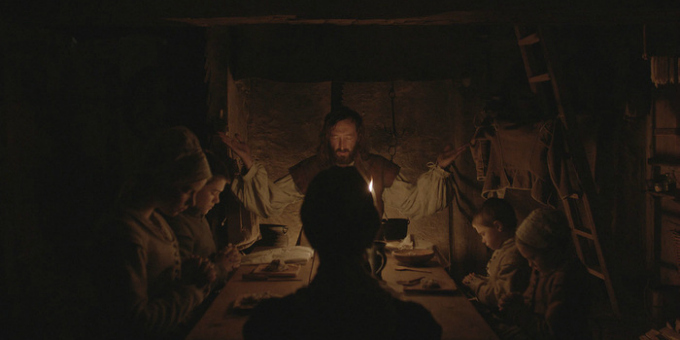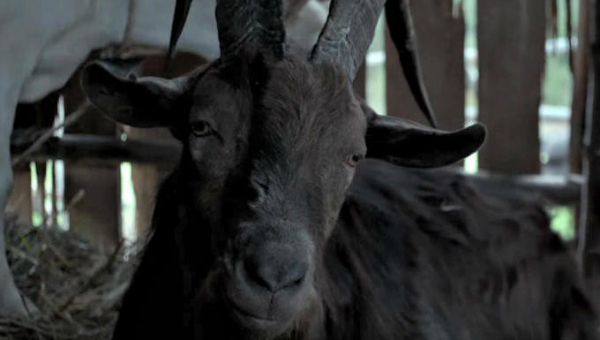 Robert Eggers’ THE WITCH is a pre-Salem folk tale in the style of Nathaniel Hawthorne’s treatment of Puritan hypocrisy, Young Goodman Brown – whose hero strays from the path and into the forest, where his faith is tested by a supernatural encounter. THE WITCH follows the story of Thomasin (Anya Taylor-Joy), a young woman whose family have been exiled from a New England colony. The Puritans were prone to in-fighting, and Thomasin’s father William (a charismatically lugubrious Ralph Ineson) stands accused of “prideful conceit”. He takes the family to live on the outskirts of a forest, and so the tale begins.
Robert Eggers’ THE WITCH is a pre-Salem folk tale in the style of Nathaniel Hawthorne’s treatment of Puritan hypocrisy, Young Goodman Brown – whose hero strays from the path and into the forest, where his faith is tested by a supernatural encounter. THE WITCH follows the story of Thomasin (Anya Taylor-Joy), a young woman whose family have been exiled from a New England colony. The Puritans were prone to in-fighting, and Thomasin’s father William (a charismatically lugubrious Ralph Ineson) stands accused of “prideful conceit”. He takes the family to live on the outskirts of a forest, and so the tale begins.
The Rural Gothic genre, including WOLF CREEK, THE WICKER MAN and STRAW DOGS, often pits the colonialist against the native – THE WITCH, however, pits community members and then family members against one another. Yes, there be witches – and whether or not they are to be apprehended as allegorical, the important thing is that they are a fact of life to our hero and her family. Eggers’ folk tale is very much in alignment with Hawthorne’s description of “The Scarlet Letter”: “a neutral territory, somewhere between the real world and fairy-land, where the Actual and the Imaginary may meet, and each imbues itself with the nature of the other.”
“We will conquer this wilderness. It will not consume us”
Domestic scenes in THE WITCH have all the kitchen sink familiarity of Spring and Port Wine. The period dialogue is quaint and colourful, but no more alienating than a Glaswegian or Yorkshire dialect. Harvey Scrimshaw’s portrayal of the oldest son, Caleb, contrasts with the other performances: far more stylised and theatrical in his approach, he almost entirely defuses the horror in a key scene which billows with high drama but lacks the cathartic grotesquerie we deserve. Interactions between the family, though, are warm and naturalistic; the Puritans were not as sexually repressed or as misogynistic as one might assume. Katherine (Kate Dickie) and her husband William share responsibility for raising their children and tending the farm. They seek counsel and comfort from one another, and show deep mutual affection and respect. They are strict but loving toward their children – until there’s a whisper of witchcraft, when the anguished family members begin to turn on one another.
 Ralph Ineson demonstrates his wood chopping technique for Take One at the Watersprite Festival
Ralph Ineson demonstrates his wood chopping technique for Take One at the Watersprite Festival
Kate Dickie’s portrayal of a grieving, fearful mother has all the power of her performance in the excellent FOR THOSE IN PERIL: another folk tale, but with a contemporary setting. It’s not so difficult to believe that her character helped William build and thatch their two-story cottage while heavily pregnant – although William’s washboard abs suggest that he could equally have thrown it together solo. The satyric Black Phillip brings unashamed depravity and mischief to the story – his humorous moues to camera continually daring us to guess whether he’s the butt of a joke, or the Devil himself. The symbology is heavily Grimms: against the backdrop of a brooding forest shine an axe, a red cloak, a silver cup, an apple. Robert Eggers’ background is in art direction and costume design, and he brings his fascination with mumming and guising to THE WITCH, collaborating with DoP Jarin Blaschke on a Brueghel and Bosch approach to both costume and cinematography. Almost every scene is shot using natural light, but the clearing in the Ontario woods has a magical realism usually seen in Spanish horror such as THE DEVIL’S BACKBONE or THE ABANDONED. This is augmented beautifully by Mark Korven’s score which often harks back to the choral hysteria of Jerry Goldsmith’s OMEN soundtrack, offering a refreshing change to the currently ubiquitous string-sting of a jump scare. Elsewhere, 17th century musical instruments bring the lost forest and its inhabitants to life.
“What went we out into this wilderness to find? The Kingdom of God.”
THE WITCH has all the bare portentousness and immersive vérité of a Haneke film: Eggers has inspired countless comparisons to the Austrian auteur. THE WITCH heralds the tragic Salem saga just as story of THE WHITE RIBBON paved the way for the Great War; it holds us in the aspic of drear, nauseating suspense almost as skilfully as CACHÉ. However, it’s Stephen King’s THE SHINING which Eggers has cited as his inspiration, and THE WITCH offers a similar depiction of isolation, cabin fever, mental contortion and nameless dread. In turn, THE WITCH won an approving tweet from King himself: “The Witch scared the hell out of me. And it’s a real movie, tense and thought-provoking as well as visceral”. Louise Ford’s editing has some scenes hang a little too loose, which may let some viewers off the hook at times, but the pay-off is worth the wait. Thomasin’s emancipation comes at a steep price, but the dark denouement is beautifully orchestrated.
“Did ye make some unholy bond with that goat?”
The children’s father urges them to “place their faith in God”, but here, infant piety offers no protection: in fact, it’s the family’s godliness which conjures the devil and invites him over the threshhold. Thomasin covets the worldly trappings of the Commonwealth, and is plagued with self-doubt. Teenagers wouldn’t be invented for another three centuries, but her adolescent turmoil is instantly relatable to a contemporary audience, as she strives to fulfil her domestic duties, scares her sister with a risky faux-confession of Satanism, and tests her father’s unconditional love to its limits. Will she keep faith as her father advises, submit to the 17th century patriarchy and hope for salvation – or admit to herself that she will always want to play on the Sabbath, and embrace the sinful life with Satan? It doesn’t matter what she thinks she is, or wants to be – she’s at the mercy of society’s arbitrary judgement of what she is. She’s faced with a real “if you can’t beat ’em, join ’em” quandary whichever way she turns – although if she chooses Satan over the Puritans’ grumpy God, she will embrace him as her own animus, not as her master…
Fun fact: Black Phillip was portrayed by Charlie the Goat, who hated Ralph Ineson and butted him so hard whilst in character that a tendon on Ineson’s rib was torn from its goddamn moorings.
httpvh://youtu.be/iQXmlf3Sefg


3 thoughts on “The VVitch”
Comments are closed.